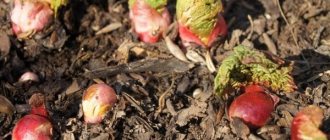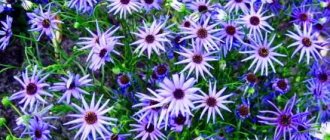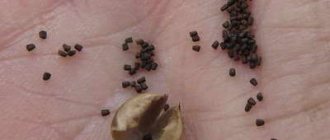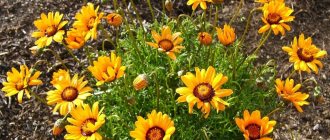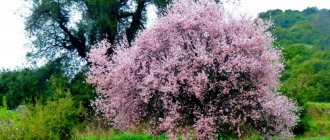Amateur flower growers grow various vines, both decorative deciduous and flowering. The advantage of vines is that they can cover an unsightly fence, an old fence, or an outbuilding that spoils the overall appearance. Not only can they decorate it all, but they can also serve as a living screen. Calestegia terry is capable of all this. This is a real assistant to gardeners and flower growers, despite its unpretentiousness. This plant can delight others with its beauty throughout the entire season, and you can observe its flowering until frost.
This flower is popularly called the Siberian rose. This is due to the fact that the flowers are similar to the inflorescences of blooming roses, but not strict and dense, but somewhat fluffy. The advantage of calistegia is that it blooms profusely in the first year of planting, starting in mid-July. The plant forms in each axil of green leaves. We can safely say that as many leaves as a flower has, there are just as many flowers, which constantly bloom until the beginning of winter.
Terry calistegia is often confused with climbing roses and clematis, but you can hardly find calistegia in gardens. Even in flower shops it is very difficult to get planting material, which is basically a stumbling block for those who do not mind having this vine in their garden.
Description of the plant
With not the most powerful stems (the usual thickness rarely exceeds 4 mm), calistegia has an impressive root, extending horizontally up to 1.5 meters. In garden plots, if it is not limited in the ground by metal or other barriers, the loach is quite capable of escaping far beyond the boundaries of its allotted place, turning into a harmful weed.
The flowers grow singly from the leaf axils and range in color from pale pink, almost white, to deep pink. The size of the corolla in different breeds can range from 3 to 7 cm in diameter.
The oblong leaves are similar to grape leaves, although they are two to three times smaller in size. The vines' vines are capable of clinging to their tendril-like leashes and rise to a height of up to 4 meters, and with good soil under the roots they are able to cover their favorite objects with a continuous carpet.
Application of calistegia
Most often, calistegia (if these are inexpensive or just wild varieties) is planted to hide a not very good view of a barn, fence, or some kind of outbuilding. More noble varieties are settled on verandas, gazebos, or simply on decorative trellises specially placed for this purpose.
Calistegia is an irreplaceable plant in this regard: in the first year of life, if its cuttings are planted densely enough, it is capable of covering any flaws in the landscape with a solid green blanket.
Terry calistegia: types and varieties for open ground
Fluffy
Country of origin: China. The stem of the vine is long, capable of climbing to a height of up to 4 meters; the vascular system of sap ducts in the body of the vine cannot cope further. In winter, during frosts, the ground with roots should be covered with a layer of fallen leaves. The flowers are large, in the form of double bells, the diameter of the inflorescence can reach 9 cm.
Hairy
In Russia it lives throughout the Far East. The shortest type of calistegia, the length of the vine does not exceed 80 cm. The foliage is yellow-green, flowers with fused petals, flat-bell-shaped, pale pink, with a corolla diameter from 3 to 6 cm.
Fence
The fastest growing species. Similar to a young birch tree in the shape of its branches and leaves. It reproduces by self-seeding, and in a couple of years it is capable of entwining everything it can cling to with long tendrils. Refers to weeds.
The leaves are triangular, leathery, the length of the vine is up to 3 m, the flowers are white or with a subtle pink tint. Capable of crossing with other types of calistegia.
Multiplex
Liana with a stem length of up to three and a half meters. A decorative look that is not afraid of severe frosts. The stem dies off in the winter, but this calistegia shoots out from the roots a month and a half before its maximum growth.
The leaves are ordinary, triangular, slightly cut. The flowers are pink, double, with a pearlescent sheen, up to 9 cm in diameter. They are long-blooming - from July to October.
Ivy or Japanese
Belongs to medium-sized varieties, the vine rarely grows to 2.5 m. Flowering lasts from mid-July to September, by which time growth stops. The usual flower size is from 7 to 9 cm, the leaves are medium sized, bright green.
Calistegia planting and care
Calistegia liana is considered an easy-to-care plant that tolerates drought and cold well.
In general, care comes down to infrequent watering, which is needed only in a long absence of rain, because excess water is harmful to this crop, so it should not be allowed to stagnate in the soil. In addition, the large bindweed root itself stores moisture well.
Morning glory is also a member of the Convolvulaceae family. An exotic plant that is very easy to grow when planted and cared for in open ground; recommendations for care can be found here.
Planting in open ground
Landing dates
Root shoots of calistegia can be planted in early spring or late autumn, shortly before snowfall. But in the second case, it is necessary to insulate the ground with mulch in the form of fallen leaves, spruce branches, straw, peat, etc.
In spring it can be propagated by cuttings. To do this, cut off the stems with three to four buds and leave 2-3 top leaves. The place of the lower cut is treated with a root formation stimulator (“Kornevin” or the like), dried for about an hour and water is added until the cuttings release roots.
Only wild plants reproduce by seed material; hybrid forms have sterile seeds.
Choice of location and lighting
The planting site is chosen next to any vertical wall to which the plant can cling with its tendrils. Calistegia can attach to trees only if its trunk diameter does not exceed 8-10 cm. Or its bark should have deep vertical and rough grooves.
The best option would be special trellises, strings stretched near the fence from bottom to top, or lattice structures of gazebos or verandas.
Illumination plays a greater role in cultivated forms, although none of the representatives of this family, even the most unpretentious, will want to grow in the shade. If a plant has settled in the shade of a tree, you can immediately say with confidence that the crown of such a tree is openwork and the shade is appropriate.
Soil preparation
Liana loves loamy and sandy soil. You just need to provide annual feeding with compost and mineral fertilizers - this is especially important for cultivated varieties. The close occurrence of groundwater is unacceptable, even seasonal (after the snow melts in the spring)
Landing rules
A groove is dug to the depth of the bayonet of the shovel. It is filled with a mixture of loose soil with ash and humus, as well as with the addition of a mineral complex. Rooted cuttings are planted in the holes made at a distance of 5 to 15 cm from each other, depending on the type of calistegia.
Then, at a distance from the planting, to a depth of 40-45 cm, vertical sheets of slate are dug in, which will prevent the plant from turning into a weed and filling the entire space of the garden or vegetable garden.
Sometimes they even cut iron barrels - a 200-liter barrel is stripped of its bottom and lid, sawed crosswise in half and dug into the ground in this form (rings), planting 5-10 cuttings inside. Their horizontal roots will definitely not escape from such a trap!
Choosing a landing site
Despite the fact that this plant is practically never found in our gardens, this does not mean that it will be bad there. All you need is to choose a properly lit area with the optimal soil composition.
Lighting
Calistegia is a liana that prefers the most illuminated places , which it simply needs for abundant and luxurious flowering.
Try to avoid shady areas located near houses or high fences, because this will only delay the beginning of flowering (by about two weeks), and the flowers themselves will not be as bright as you would like.
This is interesting: Features of choosing ornamental shrubs for a summer residence: photos and names of plants for the Moscow region
Familiarize yourself with such plants of the bindweed family as climbing rose, wisteria, campsis, actinidia, petiolate hydrangea, ornamental honeysuckle, clematis, and Chinese lemongrass.
The soil
Calistegia takes root quite well in any type of soil, but most of all it likes light and nutritious soils. So, with a sufficient content of useful microelements in the soil, the plant can grow in it for about 10 years.
It is also important that the substrate is sufficiently loose, with free air circulation. To do this, dig it thoroughly with a shovel to a “one-bayonet” depth and only after that complex mineral fertilizers are added at the rate of 2 tablespoons per 1 m², with the addition of several glasses of ash or dolomite flour.
All these components are diligently mixed in the planting hole, after which planting is carried out. The time when you need to plant calistegia is chosen based on personal considerations, but it is worth remembering that the plant takes root better when planted in spring.
"Abiga-Pik": instructions for use of the fungicide
Outdoor care
Watering
The plant drinks water very sparingly; as a rule, it has enough water from rain. Abundant watering is only needed in dry summers, and in excessively rainy summers the bindweed can even die from root rot.
Feeding and fertilizer
Fertilizers can be applied during the entire growth period. But especially intensive application can be done in the spring, as the root system forms and the calistegia gains green mass. During the flowering period, moderate feeding is required. Before wintering, it is advisable to mulch the soil in the planting area with wood ash.
Bloom
Flowering begins as early as the year of planting and in some species can last from the beginning of July until frost. The splendor of flowers depends mainly on lighting conditions; the more light, the more magnificent and brighter the flowers. Removing or not removing dried flowers does not affect the well-being of the vine, it is only a matter of aesthetics.
Trimming
The plant is an annual, so the entire vine from the root node to the top dies in late autumn. At this time, sanitary pruning is done, removing the whip from the root, and burning it. In the spring, weak shoots that are lagging in growth are also pruned.
Sometimes you have to do pruning and roots - if they managed to “escape” the restrictive barriers.
Transfer
This process is not mandatory, and is used only if the owner of the site needs to change the location of the flower. Here you will have to work hard: calistegia of all varieties is an extremely tenacious resident of the garden, and you can’t just uproot it.
And in order for the transplanted plant to take root safely in a new place, only the root system is transplanted, and then in the fall: calistegia tolerates summer transplantation very poorly.
When does Calistegia terry bloom?
Calistegia or Siberian rose when it blooms photo of flowering
It’s not for nothing that double calistegia is compared to a rose: its blossoming buds really look like roses, but not so dense and strict, but fluffy and airy. The advantage is that flowering occurs from the first year of growth. The buds form in the axils of the leaves. We can safely say: how many leaf plates, so many flowers will bloom throughout the season.
Calistegia blooms from July if planted in a sunny area. A location in the shade may delay the start of flowering to August. The plant blooms continuously until the first frost.
Colors: white, soft pink, lilac. The corollas can be simple or double, the diameter is 2-9 cm. At the end of flowering, a fruit-box is formed.
Protection from pests and diseases
The plant has good natural immunity. The only disease to which it may be susceptible is fungal infections of the roots in years with heavy rainfall. Then you need to remove the diseased parts, and treat the plants themselves with fungicides. And provide conditions. In which the soil will not become waterlogged.
Of the parasites, it is affected by spider mites - which happens, on the contrary, in dry years. The fight against them is the use of insecticides.
Sometimes the vine is attacked by garden snails or slugs. These are collected by hand, and broken eggshells are scattered around on the soil.
Reproduction
Reproduction is vegetative, mainly using rooted shoots or root segments with buds. Root propagation, subject to antiseptic rules, is practiced throughout the growing season.
The cuttings are rooted in a peat-sand mixture, and to create a greenhouse effect they are covered with cut-off parts of plastic bottles upside down.
Autumn care, shelter
Only plants one or two years old need protection from winter cold. Older, fairly rooted plants survive frosty periods without problems.
Calistegia in landscape design
The ideal solution for using calistegia in landscape design is the organization of hedges that visually expand the space. For this purpose, the technique of an arch passage between different zones of the site is often used.
Solid, but sometimes with breaks, green walls can hide unattractive elements of the landscape (most often man-made, which do not fit well into the architect-designer's plan). For this purpose, spring planting of cuttings or sections of rhizomes with growth buds is planted at a distance of 5 to 10 cm from each other.
When arranging a solid wall, remove other flowers from the proximity of bindweed - it will not allow anyone to grow and will drown out any extraneous phytoactivity.
X
Basics of flower care
The main task of the owner of calistegia is to initially choose the right location for the flower. This is the basis for successful growth and flowering.
Location
The site must be selected with good lighting and access to the sun. In shaded corners, plant growth slows down significantly, and flowers appear 2-3 weeks later.
Soil and watering
French rose is unpretentious to the composition of the soil. Deciduous, peat or loamy soil is suitable for it. It can grow in one place for a very long time (10-15 years). Does not require frequent watering and tolerates dry periods well. The proximity of groundwater is more dangerous for it. If the summer is not too dry, the flower is content with natural moisture. Additional watering is necessary only in the complete absence of rain.
Top dressing
The plant needs additional fertilizer during the period of active flowering. You need to purchase a ready-made mineral mixture from a specialized store and prepare it according to the attached instructions. Fertilizing is administered twice a month. In autumn, ash is added to the soil.
Trimming
Periodic pruning is needed throughout the flowering period. It is very important to remove dried flowers. This way you will not only help the plant, but also improve its appearance. At the end of flowering, the shoots are cut off.


